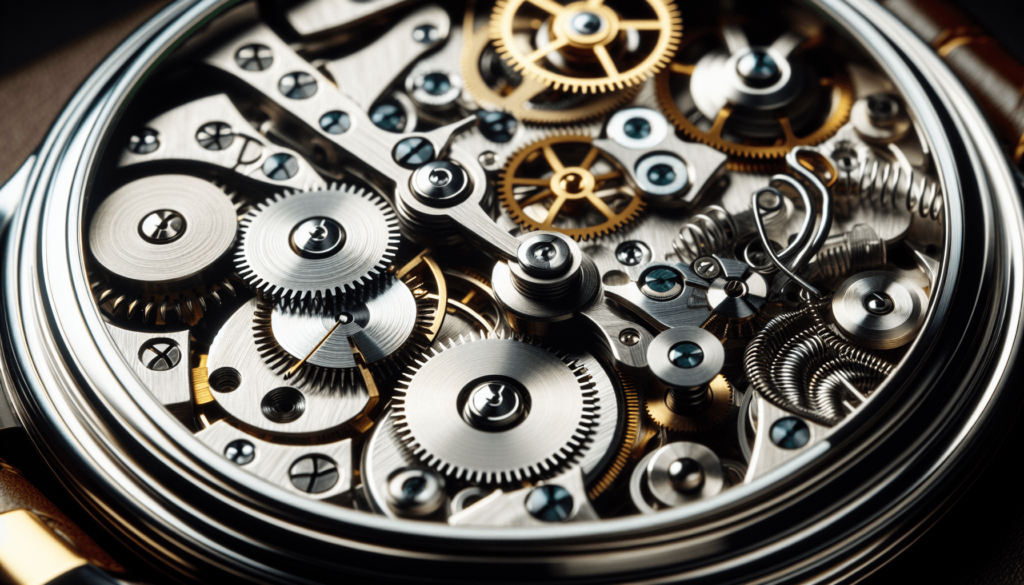
Did you know that the type of movement in a watch can significantly impact its performance? Whether you’re a watch aficionado or simply looking to understand more about how timepieces work, this article explores the different types of watch movements and how they can affect a watch’s accuracy and functionality. From mechanical movements to quartz and automatic movements, we’ll delve into the inner workings of these timekeeping marvels and uncover the secrets behind their varying performances. So, put on your metaphorical lab coat and let’s journey into the world of watch movements together!

Mechanical Movements
Definition
Mechanical movements in watches refer to the traditional method of timekeeping that relies on a complex system of gears and springs. These mechanical movements are powered by the winding of the mainspring, which stores potential energy and releases it slowly to power the timekeeping mechanism.
Components
The components of mechanical movements include the mainspring, balance wheel, escapement, and gear train. The mainspring is responsible for storing the energy, while the balance wheel regulates the release of this energy. The escapement controls the movement of the gears, ensuring accurate timekeeping, and the gear train consists of a series of gears that connect the different components and transfer the energy.
Types
There are two main types of mechanical movements: manual and automatic. In a manual movement, you need to wind the watch manually by turning the crown, while an automatic movement uses the natural motion of your wrist to wind the watch.
Advantages
Mechanical movements are highly regarded for their craftsmanship and precision. They provide a timeless and traditional feel to watches and are often considered a symbol of luxury and prestige. Furthermore, mechanical movements are often appreciated by watch enthusiasts for their intricate design and complexity.
Disadvantages
Despite their numerous advantages, mechanical movements do have some drawbacks. They tend to be more expensive than other types of movements due to the level of craftsmanship and precision required to create them. Additionally, mechanical movements may require regular maintenance and adjustment to ensure accurate timekeeping.
Automatic Movements
Definition
Automatic movements, also known as self-winding movements, are a type of mechanical movement that eliminates the need for manual winding. These movements use a rotor that rotates with the natural motion of your wrist to wind the watch.
Components
The components of automatic movements are similar to those of mechanical movements, including the mainspring, balance wheel, escapement, and gear train. The key difference lies in the addition of a rotor, which is connected to the movement and rotates with the natural movement of your wrist.
How it Works
As you wear an automatic watch, the natural motion of your wrist causes the rotor to spin. This spinning motion winds the mainspring, storing potential energy that is gradually released to power the watch. Automatic movements typically have a power reserve that allows the watch to continue running even when it is not being worn.
Advantages
The primary advantage of automatic movements is convenience. Unlike manual movements, you do not need to remember to wind the watch regularly. The natural motion of your wrist keeps the watch powered, making it a hassle-free option for daily wear. Automatic movements also have a mechanical charm and are highly valued by watch collectors and enthusiasts.
Disadvantages
One disadvantage of automatic movements is the need for regular wear or use to keep the watch powered. If you do not wear the watch for an extended period, it may stop running, requiring you to manually wind it or set the time and date when you wear it again. Additionally, automatic movements tend to be thicker than quartz movements, which can affect the overall design and wearability of the watch.
Quartz Movements
Definition
Quartz movements are a type of watch movement that relies on the oscillation of a quartz crystal to keep time. These movements are powered by a battery and are known for their accuracy and affordability.
Components
The main component of a quartz movement is the quartz crystal. This crystal is made of silicon dioxide and is cut to a precise shape. When an electrical charge is applied to the crystal, it vibrates at a consistent frequency, typically 32,768 times per second. These vibrations are converted into electrical signals that power the watch’s timekeeping mechanism.
How it Works
In a quartz movement, the battery sends electrical pulses to the quartz crystal, causing it to vibrate. These vibrations are measured by an integrated circuit, which converts them into regular electrical signals. These signals are then used to regulate the movement of the watch’s hands, ensuring accurate timekeeping.
Advantages
Quartz movements offer several advantages over mechanical movements. Firstly, they are highly accurate and can keep time within a few seconds per month. They also require minimal maintenance and adjustment, making them convenient and hassle-free for everyday wear. Additionally, quartz movements are generally more affordable than their mechanical counterparts.
Disadvantages
Although quartz movements are known for their accuracy, some watch enthusiasts may prefer the traditional charm and craftsmanship of mechanical movements. Additionally, quartz movements require the periodic replacement of the battery, which can be seen as a disadvantage compared to automatic or mechanical movements that do not rely on external power sources.
Kinetic Movements
Definition
Kinetic movements, also known as automatic-quartz movements, combine the convenience of automatic movements with the accuracy of quartz movements. These movements use the natural motion of your wrist to power a rotor, which generates electricity to charge a quartz crystal.
Components
Kinetic movements incorporate a rotor, similar to automatic movements, which translates the motion of your wrist into electrical energy. This energy is then used to charge a quartz crystal, which regulates the timekeeping mechanism of the watch.
How it Works
As you move your wrist while wearing a kinetic watch, the rotor spins and generates electricity. This electricity is stored in a capacitor or battery, which powers the quartz crystal. The crystal then regulates the movement of the watch’s hands, ensuring precise timekeeping.
Advantages
Kinetic movements offer the convenience of automatic movements, as they do not require manual winding. At the same time, they provide the high accuracy of quartz movements. This combination makes kinetic movements highly reliable and practical for daily wear. Additionally, kinetic movements are eco-friendly, as they do not rely on disposable batteries.
Disadvantages
One disadvantage of kinetic movements is that they require regular wear or use to keep the watch powered. Extended periods of inactivity can cause the watch to stop running, necessitating manual winding or reset upon wearing again. As with automatic movements, the added thickness of the rotor and capacitor can affect the design and comfort of the watch.

Solar Movements
Definition
Solar movements, also known as solar-powered or light-powered movements, use photovoltaic cells to convert light energy into electrical energy. This electrical energy is then used to power the timekeeping mechanism of the watch.
Components
The key component of a solar movement is the photovoltaic cell, often located beneath the watch’s dial. This cell is made up of a semiconductor material that generates electricity when exposed to light. The electrical energy is then stored in a rechargeable battery, which powers the watch.
How it Works
When exposed to natural or artificial light, the photovoltaic cell converts the light energy into electrical energy. This energy is stored in the rechargeable battery, which provides power to the timekeeping mechanism of the watch. Solar movements typically have a power reserve that allows the watch to continue running even when not exposed to light.
Advantages
Solar movements offer several advantages. Firstly, they are highly reliable and require minimal maintenance. The need for manual winding or battery replacement is eliminated, as the watch can keep running with regular exposure to light. Solar movements are also environmentally friendly, as they reduce the consumption of disposable batteries and promote sustainable energy usage.
Disadvantages
One potential disadvantage of solar movements is their dependence on light as a power source. If the watch is not exposed to sufficient light, it may stop running, requiring manual winding or reset upon wearing again. Additionally, solar movements may have a thicker profile than other movements, affecting the overall design and comfort of the watch.
Hybrid Movements
Definition
Hybrid movements, as the name suggests, combine two different types of watch movements to offer a unique blend of features and functionalities. These movements often combine mechanical or automatic movements with electronic or digital components.
Components
Hybrid movements typically consist of mechanical or automatic watch movements combined with digital or electronic components. The mechanical or automatic movement provides the traditional timekeeping and mechanical aesthetics, while the digital or electronic components offer additional features such as smartwatch functionality or advanced chronograph capabilities.
How it Works
The specific workings of hybrid movements depend on the combination of mechanical and digital components. Some hybrid movements may have two separate mechanisms, one for the mechanical movement and one for the digital functions, while others integrate the digital features into the mechanical movement itself. These movements often utilize a combination of gears, sensors, and microchips to provide the desired functionalities.
Advantages
Hybrid movements combine the best of both worlds, offering the timeless appeal and craftsmanship of mechanical movements alongside the advanced features and convenience of digital components. These movements can provide additional functionalities such as fitness tracking, smartphone notifications, or multiple time zones. Hybrid movements cater to individuals who appreciate both the traditional and modern aspects of watch technology.
Disadvantages
One potential drawback of hybrid movements is the increased complexity and potential for technical issues. The integration of mechanical and digital components can lead to higher manufacturing costs and potential maintenance or repair challenges. Additionally, the added digital features may require regular charging or battery replacements, depending on the specific hybrid movement.

Digital Movements
Definition
Digital movements represent a departure from traditional mechanical movements and utilize electronic components to display the time and other functions. These movements are powered by batteries and are known for their accuracy and ease of use.
Components
The main component of a digital movement is an electronic module, which consists of a microchip programmed to control the watch’s functions. Digital movements also include a liquid crystal display (LCD) or light-emitting diode (LED) screen to display the time and other information. These movements are powered by batteries, typically lithium ones.
How it Works
Digital movements rely on the electronic module to control the display and functions of the watch. The module receives electrical signals from the battery and processes them to drive the LCD or LED screen. Digital movements often offer additional features such as timers, alarms, and calendar functions.
Advantages
Digital movements offer several advantages, including high accuracy and ease of use. These movements can provide precise timekeeping and often offer additional functions such as multiple time zones, alarms, and stopwatch capabilities. Digital watches are generally affordable and require minimal maintenance, making them suitable for everyday wear.
Disadvantages
One disadvantage of digital movements is their lack of the traditional mechanical craftsmanship and charm. Some individuals may prefer the intricate design and craftsmanship of mechanical movements. Additionally, digital watches often require periodic battery replacements and may lack the longevity of mechanical or automatic movements.
Tourbillon Movements
Definition
Tourbillon movements are a type of mechanical movement that aim to improve accuracy by counteracting the effects of gravity on the watch’s balance wheel and escapement. These movements are often considered as a pinnacle of horological craftsmanship.
Components
The components of a tourbillon movement are similar to those of mechanical movements, including the mainspring, balance wheel, escapement, and gear train. However, the key feature of a tourbillon movement is the addition of a tourbillon cage, which houses the balance wheel and escapement and rotates continuously.
How it Works
The tourbillon cage rotates continuously, typically completing one full rotation per minute or a different interval, depending on the design. This rotation aims to counteract the gravitational forces that can affect the accuracy of the watch’s timekeeping. By continuously changing the position of the balance wheel and escapement in relation to gravity, tourbillon movements strive to reduce errors caused by gravity.
Advantages
Tourbillon movements are highly regarded for their intricate design and craftsmanship. While their primary purpose is to improve accuracy, they are often considered a showcase of a watchmaker’s skill and expertise. The mesmerizing rotation of the tourbillon cage adds a captivating visual element to the watch.
Disadvantages
One of the main challenges of tourbillon movements is their complexity and high manufacturing costs. The intricate design and assembly required to create a tourbillon movement make them significantly more expensive than other types of movements. Additionally, tourbillon movements are less effective in countering the effects of gravity when the watch is in a stationary position, as the rotation of the cage is most impactful when the watch is in motion.

Chronograph Movements
Definition
Chronograph movements are specialized movements that include a stopwatch function in addition to timekeeping. These movements allow you to measure elapsed time, making them popular choices for sports watches and timing events.
Components
The components of a chronograph movement include the regular timekeeping movement, which powers the watch, as well as additional mechanisms for the stopwatch function. These mechanisms typically consist of an additional set of gears, levers, and pushers that control the activation, stopping, and resetting of the stopwatch.
How it Works
Chronograph movements have the usual timekeeping mechanism, powered by either a mechanical, automatic, or quartz movement. The additional components for the stopwatch function allow you to start, stop, and reset the timing of the chronograph. The chronograph functions are usually operated through pushers on the side of the watch.
Advantages
The main advantage of chronograph movements is their ability to measure elapsed time accurately. This makes them invaluable for sports activities, timing events, or everyday tasks that require precise timing. Chronograph watches are versatile and can be worn for both functional and aesthetic purposes.
Disadvantages
One potential disadvantage of chronograph movements is their increased complexity. The additional components required for the stopwatch function can make the movement more prone to technical issues and may require more frequent maintenance. Additionally, chronograph watches tend to have a thicker profile due to the added mechanisms, which can affect the comfort and overall design of the watch.
Skeleton Movements
Definition
Skeleton movements, also known as open-worked movements, showcase the intricate internal mechanisms of a watch by removing or partially exposing the watch’s dial and plates. These movements offer a glimpse into the craftsmanship and engineering that goes into creating a watch.
Components
The components of skeleton movements are similar to those of mechanical movements, including the mainspring, balance wheel, escapement, and gear train. However, in skeleton movements, parts of the dial and plates are cut away or removed to expose the internal mechanisms.
How it Works
Skeleton movements aim to highlight the complexity and artistry of watchmaking by showcasing the intricate gears, springs, and other components that make the watch tick. These movements often involve precision cutting and finishing techniques to create visually appealing patterns and designs within the movement.
Advantages
One of the main advantages of skeleton movements is their aesthetic appeal. These movements offer a unique and fascinating view into the inner workings of a watch, allowing you to appreciate the craftsmanship and intricacy of the timekeeping mechanism. Skeleton watches are highly sought after by watch enthusiasts and collectors for their artistic and technical value.
Disadvantages
One potential drawback of skeleton movements is their reduced legibility. With parts of the dial and plates removed or partially exposed, it may be more challenging to read the time compared to watches with fully covered dials. Additionally, the nature of skeleton movements often requires more delicate and intricate craftsmanship, making them more susceptible to damage and requiring careful handling and maintenance.
In conclusion, the different types of watch movements offer a wide range of choices to suit various preferences and needs. Mechanical movements provide a traditional and luxurious feel, while automatic movements offer the convenience of self-winding. Quartz movements are highly accurate and affordable, while kinetic movements combine the best of automatic and quartz technology. Solar movements provide environmentally friendly power, and hybrid movements combine mechanical and digital features. Digital movements offer precise timekeeping and additional functions, while tourbillon movements showcase horological mastery. Chronograph movements allow for precise timing, and skeleton movements offer a glimpse into the intricate world of watchmaking. With such a diverse selection, there is a watch movement for every individual’s taste and lifestyle.
